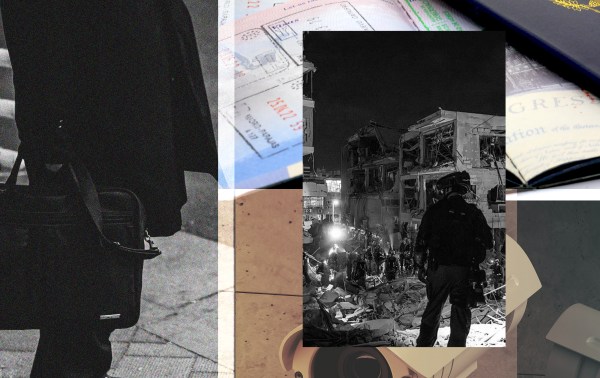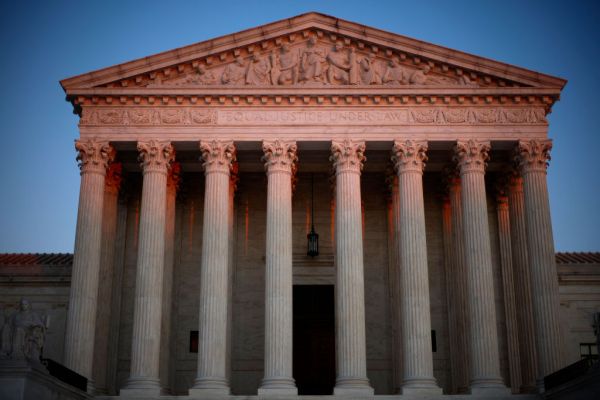The horrific murder of 19 children and two teachers at an elementary school in Uvalde, Texas, has brought guns back to the public debate. One side renews its demands for national legislators to do something to tamp down on gun violence. The other insists on the importance of Second Amendment rights, and claims the answer is more guns, not fewer.
Amid this dispute, a small but vocal group is pushing for a policy it sees as a détente in America’s never-ending war over guns: red flag laws.
Also sometimes called “Gun Violence Restraining Orders” or “Extreme Risk Protection Orders,” red flag laws allow a court to temporarily seize a person’s guns if he poses a threat to himself or others. Nineteen states and the District of Columbia currently have some form of the provision, and incentives for more states to pass them are under discussion in Congress.
In theory, red flag laws can resolve the impossible conflict between America’s high rates of gun violence and the Second Amendment’s strong protection of the right to keep and bear arms. By only targeting those individuals whom a court decides need to be temporarily relieved of weapons, they reduce the risk of violence while protecting the overwhelming majority of law-abiding gun owners.
But are red flag laws the solution we have been looking for? The evidence, which I review below, gives reason for doubt. At best, studies show, red flag laws reduce suicide; at worst, they don’t even do that.
This doesn’t mean red flag laws don’t work. Rather, it seems likely we can’t discern their effects because they aren’t used often enough. But if that’s the case, the balancing of rights and safety—the ever-present dilemma of the gun control debate—once again rears its head. If we want red flag laws to save lives, they need to be used far more aggressively. But whether that’s politically or legally possible is a real, and daunting, question.
Do Red Flag Laws Work?
There are clearly individual instances in which red flag laws prevent violence, concrete cases where someone threatened himself or others, was red flagged, and did not hurt anyone. Research based on individual cases in Indiana and Connecticut—the first two states to implement red flag laws—estimated that one suicide was prevented for every 10 to 20 gun orders issued in the cases examined.
But if red flag laws are going to meaningfully reduce mass shootings, or gun deaths in general, they need to work at scale. There were roughly 19,000 gun homicides and 24,000 gun suicides in 2020 (the most recent year for which good data are available); there were, by one hotly debated definition, about 40 mass shootings. If red flag laws don’t have a measurable effect on these outcomes, then they aren’t the solution proponents want them to be.
Ideally, we’d measure the effect of red flag laws by having jurisdictions randomly adopt them or not, and then compare gun violence rates in those with the laws to those without, letting us isolate the effect of the law from all of the other differences between jurisdictions. In reality, we can’t force states or cities to randomly pass laws. But social scientists have designed statistical methods that give them the next best thing, identifying “natural experiments” which can be made to resemble these ideal conditions. In total, I identified five studies which use an experiment-like method to try to assess what red flag laws do.
Two studies offer reason for hope. Kivisto and Phalen 2018 looks at the effects of Indiana’s law, implemented in 2005, and Connecticut’s law, implemented in 1999 but (according to the authors) first really aggressively enforced in the wake of the Virginia Tech shooting in 2007. The authors find that relative to a “synthetic control” composite of other states, Indiana’s law reduced firearm suicides by 7.5 percent, while Connecticut saw a 1.6 percent reduction, ballooning to a 13.7 percent reduction after Virginia Tech. A second paper, Dalafave 2020, compares suicides and homicides in states with and without red flag laws through 2018. The study finds a statistically significant reduction in gun (by 6.4 percent) and overall suicides (3.7 percent), but not in homicides.
Together, these two studies suggest that at the very least, red flag laws might reduce gun suicides, even if they don’t work on homicides. Unfortunately, some other studies cast doubt.
The first pessimistic study, Lott and Moody 2019, is by John Lott, a prominent academic opponent of gun control. That doesn’t necessarily render his findings suspect, but it does make it less surprising that he and his coauthor find no effect of red flag laws on homicides, suicides, or mass shootings. They use a variety of methods, including a simulation exercise which allows them to more precisely estimate if the significant negative effect on firearm suicides is due to chance—they find that it is.
Then there’s Harris 2021, a University of Montana master’s thesis that nonetheless offers the most comprehensive look at the effect of red flag laws. Harris uses monthly data through 2019, meaning it includes some red flag laws not in Dalafave 2020. Harris initially finds that red flag laws reduce homicides and suicides, but then shows that both measures were trending downwards in red flag states prior to the implementation of their laws. This “pre-trend” gives the illusion of an effect. This, Harris suggests, might be because mass shootings instigate both red flag laws and other changes that in turn effect gun violence.
The last nail in the coffin is Pear et al. 2022, coauthored by Garen Wintemute—a gun control researcher who is more or less Lott’s spiritual opposite. The study looks at California’s red flag law, comparing San Diego County to a “synthetic control” county composed of 28 others. It finds no statistically significant effect on gun homicides, gun injuries, or gun self-injuries in the study period.
False Positives, False Negatives
These results are disappointing, to put it mildly. But why do they come out that way?
One explanation is that red flag laws are self-defeating. Maybe the existence of a red flag law induces a change in would-be shooters’ behavior, causing them to obscure their intent and blunting the law’s ability to stop them from committing a crime. That’s possible, but it makes strong assumptions about the planning skills of would-be offenders and their rationality with regards to laws.
Here’s a simpler explanation: Red flag laws are not used very often. In Indiana, there were only about 67 cases a year in the first two years of the state’s red flag law implementation, two-thirds of which were for suicide risks. There were just 93 petitions filed in the first 15 months of Oregon’s law. In the first four years of California’s “gun violence restraining order” law, there were only 1,094 people red flagged, and only 725 actually saw their guns taken away. In Pear et al.’s study, there were only 355 orders in four years, in a county of 3.3 million people and 80 to 120 murders a year, according to the CDC.
Red flag laws’ infrequent use is apparent every time there’s a mass shooting in a red flag state and people ask why the perpetrator wasn’t red flagged. Mass shooters tend to display the same traits over and over again; if we red flagged more aggressively, the argument goes, we could really save lives. On the one hand, this is obviously correct: If we red flagged everyone in the United States, there would be very little gun violence. But that same reductio raises important questions about how much we can expect red flag laws to do.
One of the appeals of red flag laws is that they have a relatively low false positive rate, particularly by comparison to other gun control proposals. Mandatory buy-backs or assault weapons bans sweep up lots of people who will never misuse their guns along with the people who will. Red flags try to avoid this, by only targeting gun owners at risk of hurting themselves or others. But by the same token, they almost certainly have a high false negative rate, i.e. they miss a lot of people.
If we want to make red flag laws have more of an impact, we need to reduce that false negative rate, which means increasing the number of red flags, which means increasing the false positive rate. Most mass shooters share certain characteristics, but lots of people who have the same characteristics do not go on to commit mass shootings. If we red flag all such people, we end up dramatically increasing our false positive rate. The same observation obtains for gun homicides, or even suicides: 98 percent of those who express an intent to commit suicide do not actually go on to a die by suicide, for example. In fact, we already know from the research that red flag laws scoop up a lot of non-risks—if 1 in 10 red flags prevents a suicide, 9 in 10 do not. How high does this false positive rate have to get to have a population-level impact?
One argument against this view is that red flag laws are, as Dispatch Senior Editor David French put it, not about “predicting a mass shooting,” but about temporarily taking guns away in the case “where someone has indicated that they might be a threat to themselves or others.” In other words, red flag laws respond uniformly to certain behavior. This view, however, does not change the false positive problem. Firstly, those behaviors only merit depriving a right because they pose a risk of bad behavior—a risk which is subject to all the same probabilistic concerns already laid out. Secondly, scaling up red flag laws means red flagging less cut-and-dry risk cases—again raising the risk of false positives.
I suspect that red flag laws may still be more politically tractable than other gun control legislation. But if we would like to see them have a real impact on gun violence, they need to be applied far more vigorously than they currently are—a view with which French seems to agree. Vigorous enforcement, however, runs up against exactly the problems that have plagued other policies: balancing the rights of law-abiding citizens (i.e. minimizing false positives) with avoiding letting would-be offenders arm themselves (i.e. minimizing false negatives).
Red flag laws are, in other words, not the solution to gun control’s conundrum that some would have them be. If we want them to really reduce gun violence, we still have to grapple with the hard trade-off between rights and risk—an unavoidable part of this debate.
Charles Fain Lehman is a fellow at the Manhattan Institute and a contributing editor of City Journal.







Please note that we at The Dispatch hold ourselves, our work, and our commenters to a higher standard than other places on the internet. We welcome comments that foster genuine debate or discussion—including comments critical of us or our work—but responses that include ad hominem attacks on fellow Dispatch members or are intended to stoke fear and anger may be moderated.
With your membership, you only have the ability to comment on The Morning Dispatch articles. Consider upgrading to join the conversation everywhere.